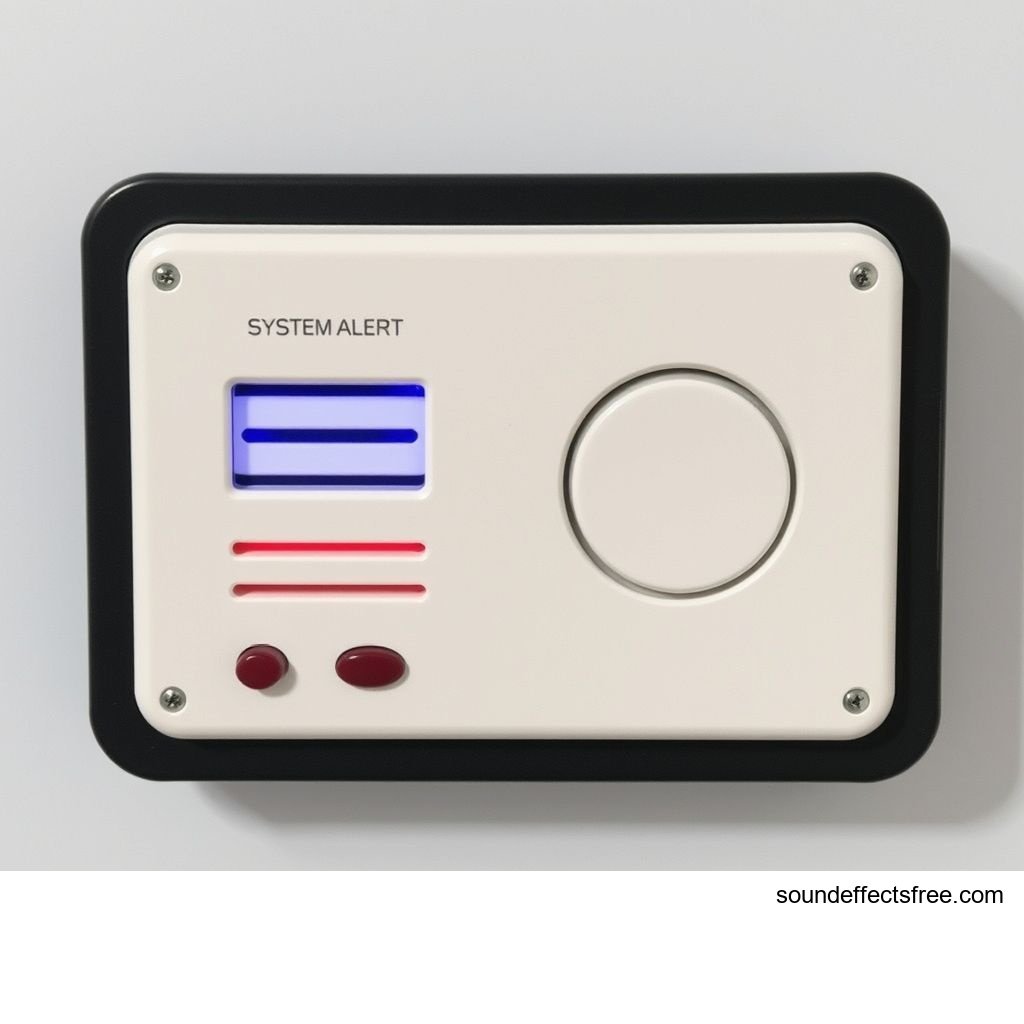System Alert Chime: Melodic UI Sounds
A well-designed chime is more than just a sound. It delivers crucial information instantly. This simple melodic audio cue guides users. It enhances their interaction with digital interfaces. In Japanese design, these chime sounds are carefully crafted. They ensure clarity and a pleasant user experience. A system chime creates a subtle yet powerful connection. It signals an alert or a completion. This careful approach to UI sound design is common. It highlights the importance of the user's journey.
Applications in Media
Digital interfaces rely on audio cues. A precisely timed chime can transform user experience. It provides immediate feedback. This makes interactions feel smooth. Users understand system states instantly. The right chime can reduce frustration. It can enhance overall satisfaction. Consider the subtle ring of a successful transaction. Or the soft notification of a new message. These sounds guide without being intrusive.
Industry-Specific Uses
Many industries use custom chime sounds. Video games employ them for item collection. They signal quest updates. A distinct chime marks level completions. Mobile applications use chime sounds for new messages. They confirm user input. Think of the unique chime from a popular messaging app. Public transport systems in Japan often use melodic chime sequences. These announce station arrivals. They signal door closures. This use of a clear, sometimes two-tone, chime helps navigation. It provides reassuring confirmation. Payment terminals also use a simple chime. This confirms successful transactions. It is a universal audio effect.
Creative Techniques
Designers use various techniques for chime implementation. They can vary the pitch. A rising pitch often indicates success. A falling pitch might signal an error alert. Different timbres can distinguish messages. A bright, clear chime might be for a critical notification. A softer, more mellow chime could be for background updates. Melodic patterns also convey meaning. A short, distinct melody can brand an interaction. This makes the chime instantly recognizable. Subtlety is key. The sound should not overwhelm the user. It should simply enhance the moment.
Technical Analysis
Understanding the properties of a chime is vital. It allows for effective sound design. A good chime balances clarity and brevity. It needs to cut through other sounds. Yet it must remain pleasant to hear. The technical characteristics shape its impact. Every chime has a unique sonic signature. This profile determines its emotional effect.
Waveform Characteristics
A typical chime waveform shows a sharp attack. This means the sound begins instantly. It has a quick decay. The sound fades rapidly after its initial peak. There is often minimal sustain. The sound does not hold its volume for long. Finally, it has a short release. The sound ends quickly and cleanly. This sharp, transient nature is crucial. It ensures the chime is heard then disappears. This prevents the sound from lingering. It avoids becoming annoying. A crisp waveform makes the chime effective.
Frequency Profile
Most effective chime sounds reside in mid to high frequencies. These frequencies are easily audible. They do not conflict with human speech. They also cut through background noise. A typical two-tone chime involves two distinct pitches. These pitches are usually consonant. They create a pleasing, harmonious sound. This makes the chime memorable. It is easy on the ears. The specific frequencies chosen can influence perception. Higher frequencies often convey urgency. Lower frequencies can suggest completion or depth. The melodic intervals are important. They define the character of the chime.
Production Tips
Creating or selecting the perfect chime requires attention to detail. Quality production ensures the sound performs well. It must be clear across various devices. It also needs to convey the intended message. A poorly produced audio effect can detract from the user experience. Investing in good sound samples is essential. Consider the context of the chime.
Recording & Editing
High-quality microphones are essential for recording original chime sounds. Record in a quiet environment. This minimizes unwanted noise. Edit the raw audio carefully. Remove any hum or hiss. Use noise reduction tools if necessary. Apply equalization to shape the tone. Boost frequencies that enhance clarity. Cut frequencies that muddy the sound. Add a subtle reverb for ambience. But avoid overdoing it. The chime should remain crisp. Pro Sound Effects offers professional sound libraries. They provide excellent starting points for your next chime.
Software Tools
Digital Audio Workstations (DAWs) are indispensable. Programs like Ableton Live or Logic Pro X are great. They offer powerful editing capabilities. Synthesizers can also generate unique chime sounds. VST plugins provide endless possibilities. They can create metallic tones. They can produce ethereal bells. Experiment with different sound sample types. Layering multiple sfx can create a richer chime. Mastering tools ensure consistent volume. They also optimize the chime for different playback systems. Always test your chime on various devices. This includes phones, tablets, and computers.
Creative Implementation
A single chime is powerful. Yet its impact can be amplified. Creative layering methods enhance the user experience. Spatial effects can add depth. Thinking beyond a simple beep helps. A well-placed melodic chime can make a huge difference.
Layering Methods
Combine your main chime with other subtle sounds. A soft click can precede an alert chime. A gentle whoosh can follow it. This creates a more dynamic audio effect. Layering adds complexity. It provides a richer audio tapestry. Ensure layers are harmonious. They should not clash. The overall sound should remain cohesive. Each element should enhance the primary chime. This technique is common in UI design. It makes interactions feel more polished. Consider Related chime sounds for inspiration.
Spatial Effects
Subtle spatial effects add realism. They create a sense of depth. A touch of stereo width makes the chime feel more immersive. Small amounts of delay or reverb can place the chime in a virtual space. This makes the sound less flat. It adds a premium feel. However, use these effects sparingly. An overly spacious chime can lose its clarity. The goal is to enhance, not obscure. A perfectly placed melodic chime feels natural. It blends seamlessly with the interface.
Sound Pack Integration
Finding the right chime is often about context. A chime rarely stands alone. It belongs to a family of sounds. Integrating it well with other audio assets is crucial. This ensures a consistent and harmonious user experience.
Using with Other Sounds
The "System Alert Chime" works best when part of a cohesive sound pack. Its specific melodic quality should align. It should match other UI sounds. For example, use it alongside a "confirm" sound. Or pair it with an "error" sfx. Ensure volume levels are balanced. The chime should be prominent but not jarring. Consistency in tone helps user recognition. If your confirmation sound is UI Confirm Tap, ensure your chime complements it.
Complete Collection
A comprehensive sound pack offers everything needed. It provides a full suite of UI audio effects. These often include various chime sounds. They also have clicks, swipes, and transitions. All sounds within the pack are designed to work together. This saves time and ensures quality. Get the full sound pack for comprehensive audio solutions. This ensures every notification and alert sounds perfect.
FAQ Section
Q1: What makes a "System Alert Chime" effective? A well-designed chime is clear, concise, and distinctive. It grabs attention without being annoying. Its melodic qualities should be pleasing. This ensures an effective alert.
Q2: How important is the frequency profile for a chime? The frequency profile is crucial. High-frequency elements make a chime cut through noise. A good two-tone chime ensures audibility. It prevents clashing with other sounds.
Q3: Can a "chime" be used for different types of alerts? Yes, a single chime can be adapted. Varying its pitch or layering it can signal different alert types. This allows for versatile notification feedback.
Q4: What are the benefits of using a sound pack for chimes? A sound pack provides consistency. It offers a range of pre-designed chime sounds. They are all made to work together. This simplifies the audio design process.
Q5: How do Japanese digital interfaces use chimes differently? Japanese interfaces often prioritize subtle, melodic chimes. They aim for clarity and politeness. This enhances the user's overall digital experience. The chime acts as a gentle guide.





